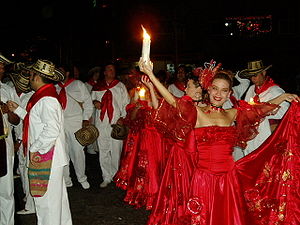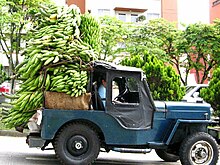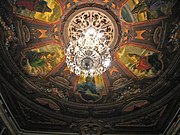
Colombia is a unitary republic made up of thirty-two departments and a Capital District. Each department has a governor (gobernador) and an Assembly, elected by popular vote for a four-year period. The governor cannot be re-elected in consecutive periods. Departments are country subdivisions and are granted a certain degree of autonomy.

Ibagué is the capital of Tolima, one of the 32 departments that make up the Republic of Colombia. The city is located in the center of the country, on the central mountain range of the Colombian Andes, near Nevado del Tolima. It is one of the most populous cities in the country, with about 529,635 inhabitants, making it the seventh (7th) most populous in Colombia. It was founded on October 14, 1550, by the Spanish captain Andrés López de Galarza. The city of Ibagué is divided into 13 communes and the rural area has 17 corregimientos. As the capital of the department of Tolima the city hosts the Government of Tolima, the Departmental Assembly, and the Attorney General's Office. It is the main epicenter of political, economic, administrative, business, art, culture, and tourism activities in the area.
The carnival in Colombia was introduced by the Spaniards. The Colombian carnival has incorporated elements from European culture, and has managed to syncretise, or re-interpret, traditions that belonged to the African and Amerindian cultures of Colombia. There is documentary evidence that the carnival existed in Colombia in the 17th century and had already caused concern to the colonial authorities, who censored the celebrations, especially in the main centers of power such as Cartagena, Bogotá and Popayán. The carnival, therefore, continued its evolution and re-interpretation in the small and at that time unimportant towns where celebrations did not offend the ruling elites. The result was the uninterrupted celebration of carnival festivals in Barranquilla, and other villages along the lower Magdalena River in northern Colombia, and in Pasto, Nariño in the south of the country. In modern times, there have been attempts to introduce the carnival in the capital, Bogotá, in the early 20th century, but it has always failed to gain the approval of authorities. The Bogotá Carnival has had to wait until the 21st century to be resurrected, this time, by the authorities of the city. Colombia is recognized by its large variety of festivals, carnivals and fairs. Most towns have their own, ranging from those celebrating coffee to the ones held in honor of the town's Saint feast. The common characteristics of the festivals are the nomination of a beauty Queen and the setting up of public dance floor.

The Municipalities of Colombia are decentralized subdivisions of the Republic of Colombia. Municipalities make up most of the departments of Colombia with 1,122 municipalities (municipios). Each one of them is led by a mayor (alcalde) elected by popular vote and represents the maximum executive government official at a municipality level under the mandate of the governor of their department which is a representative of all municipalities in the department; municipalities are grouped to form departments.

The contribution of travel and tourism to GDP was US$5,880.3bn in 2016. Tourism generated 556,135 jobs in 2016. Foreign tourist visits were predicted to have risen from 0.6 million in 2007 to 4 million in 2017. Responsible tourism became a peremptory need for Colombia because it minimizes negative social, economic and environmental impacts and makes positive contributions to the conservation of natural and cultural heritage.

The Climate of Colombia is determined for geographic and atmospheric elements: temperature, precipitations, solar radiation, wind, latitude, altitude, atmospheric. This generate a large number of climate variants in Colombia, from more hottest, until the more cold with temperatures of 0 °C in high mountains. Generally is tropical and temperate as a result of its geographical location near the Equator presenting variations within five natural regions and depending on the altitude, being all isothermal. Because it has a very low latitude, there are no four seasons.

The judiciary of Colombia is a branch of the State of Colombia that interprets and applies the laws of Colombia, to ensure equal justice under law, and to provide a mechanism for dispute resolution. The judiciary comprises a hierarchical system of courts presided over by judges, magistrates and other adjudicators.
Colombia's architectural heritage includes Spanish colonial architecture including Catholic churches. Its modern architecture represents various International Style architecture. In the postmodern architecture era a wave of innovate and striking buildings have been designed.

Colombian geography presents formidable challenges to roadbuilders, needing to communicate its largest production centers deep inside the Andes with major ports in both the Atlantic and Pacific oceans. All of this carries a heavy premium to roadbuilding, compared with the cost of building highways in flat terrains. Therefore, the Colombian government is undertaking a great effort in order to improve the highway system, under the name of Fourth Generation Highways, with the intent of updating major roads to international safety and speed standards. This project will be funded through both public and private capital, with a total worth of nearly US$23 billion, accounting to a yearly investment of 3% of national GDP, improving or building a grand total of over 8.000 km of roads. These roads are expected to improve Colombia's competitiveness in order to successfully take advantage of the many trade agreements signed in recent years.
Juan Diego Ramírez Calderón is a male road cyclist from Colombia.

The Bambuco Pageant and Folkloric Festival is the largest and most important celebration in Huila Department and one of the most important celebrations in southern Colombia. It is celebrated annually in the city of Neiva during the Feast of Saints Peter and Paul and attracts a considerable number of Colombian and foreign tourists. The festival was declared National Cultural heritage by the Congress of Colombia in 2006.

Hipermercados Jumbo is a Chilean chain of hypermarkets operating in Chile, Argentina and in Colombia.
The 2011 Categoría Primera A season is the 64th season of Colombia's top-flight football league.
The 2014 Vuelta a Colombia was the 64th edition of the Vuelta a Colombia cycling stage race, and was held from 6 to 17 August 2014. It was won by the Spanish cyclist Óscar Sevilla.
The 2018 Copa Colombia, officially the 2018 Copa Águila for sponsorship reasons, was the 16th edition of the Copa Colombia, the national cup competition for clubs of DIMAYOR. The tournament was contested by 36 teams. Junior were the defending champions, but were knocked out by Atlético Nacional in the quarterfinals. Atlético Nacional were the champions after beating Once Caldas 4–3 on aggregate in the final, and qualified for the 2019 Copa Libertadores.
The 2021 Copa Colombia, officially the Copa BetPlay Dimayor 2021 for sponsorship reasons, was the 19th edition of the Copa Colombia, the national cup competition for clubs of DIMAYOR. The tournament was contested by 35 teams and began on 10 March 2021. It ended on 24 November 2021, with Atlético Nacional winning their fifth title in the competition after defeating Deportivo Pereira in the double-legged final series by a 5–1 aggregate score. As champions, Atlético Nacional qualified for the 2022 Copa Libertadores.
The 2022 Copa Colombia, officially the Copa BetPlay Dimayor 2022 for sponsorship reasons, is the 20th edition of the Copa Colombia, the national cup competition for clubs affiliated to DIMAYOR, the governing body of professional club football in Colombia. The tournament is contested by 35 teams and began on 9 February 2022. It will end on 2 November 2022, with the champions being entitled to qualify for the 2023 Copa Libertadores.

The 2022 monkeypox outbreak in Colombia is a part of the outbreak of human monkeypox caused by the West African clade of the monkeypox virus. The outbreak reached Colombia on 23 June 2022.
Miss Colombia 2022 will be the 69th Miss Colombia pageant, to be held in 13 November 2022. Valentina Espinosa of Bolivar will crown her successor at the end of the event.
















